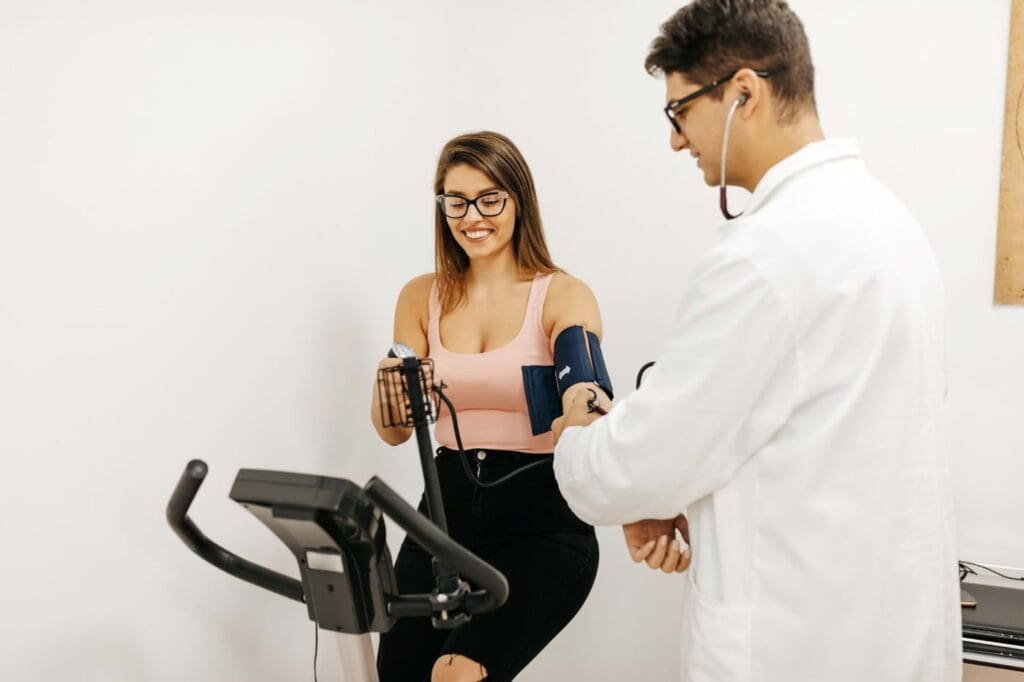Hospital credentialing process ensures that hospital employees and external contractors – including pharmaceutical vendors and allied health professionals – meet baseline health standards and are fit for duty.
The healthcare credentialing process is a vital component of evaluating workforce readiness. It includes conducting pre-employment and periodic medical examinations, as well as ensuring that individuals have the appropriate training and certifications. Efficient and accurate medical exams are essential for streamlining the credentialing process and enhancing organizational preparedness.
Read on to learn more about hospital credentialing, key steps in the process, tips for speeding up the process, and compliance best practices.
![]() Key Takeaways
Key Takeaways
- Hospital credentialing verifies provider qualifications, medical fitness, and regulatory compliance to ensure safe and effective patient care.
- Efficient pre-employment and periodic medical exams accelerate onboarding, reduce liability, and improve workforce readiness.
- Credentialing involves application review, medical evaluation, background checks, and primary source verification.
- Delays in credentialing often stem from inconsistent standards, manual workflows, and incomplete documentation.
- Fast and accurate medical exams improve staffing agility, minimize onboarding delays, and support compliance with The Joint Commission and CMS.
- Digital solutions like credentialing software, EHR integration, and workflow automation help streamline the process.
- Partnering with an experienced occupational health provider enables centralized services and real-time credential tracking.
- Compliance with TJC, CMS, OSHA, HIPAA, and state licensing laws is essential to avoid legal risks and ensure patient safety.
Table of Contents
What is Hospital Credentialing?
Hospital credentialing, also known as hospital clearance, is the process through which a hospital or healthcare facility verifies a provider’s professional qualifications and evaluates their medical fitness to deliver patient care safely and effectively.
Why is Credentialing Essential for Hospitals and Healthcare Facilities
Hospital credentialing plays a crucial role in risk management, legal compliance, workforce capability, and maintaining an institution’s reputation.
Provider competence or performance issues are a major factor in malpractice claims. By verifying education, licensure, and malpractice history, credentialing helps hospitals identify high-risk providers and prevent potential harm.
Additionally, credentialing is a legal and regulatory requirement for hospitals. Organizations accredited by The Joint Commission must adhere to strict credential standards to ensure provider competency and patient safety. Additionally, hospitals participating in the Center for Medicare and Medicaid Services (CMS) programs are mandated to implement formal credentialing processes as part of federal compliance.
Robust credentialing programs are linked to more competent providers and improved patient outcomes. They also support a hospital’s public image. According to a study by the National Institutes of Health, when choosing care, 61% of patients consider the hospital’s reputation, and 51% value the physician’s experience.
Key Steps in the Credentialing Process
Key steps in the credentialing process include:
- Application process: The applicant provides information on education and training, qualifications, residency, licenses, certifications, malpractice claims, and career history.
- Medical exam: Hospitals often require healthcare providers to undergo a medical or physical examination to confirm they are medically fit to perform their duties. The exam may include a physical and mental health assessment, immunization verification, drug and alcohol testing, and tuberculosis screening.
- Primary Source Verification (PSV): The hospital or healthcare organization verifies the applicant’s information by contacting the original sources, such as the university, certifying body, or former employer.
- Background check: The credentialing organization reviews the provider’s criminal history, malpractice history, drug use, and other relevant information with data banks, such as the National Practitioner Data Bank (NPDB).
- Review by credentialing committee: A committee or experienced medical professional reviews the application and other documentation to assess the provider’s competence and fitness to practice.
- Privileges decision: After committee review, recommendations are forwarded to a medical executive or governing body for final approval.
- Recredentialing: Typically done every two years, recredentialing includes a reassessment of the provider’s performance, compliance, and any disciplinary actions or complaints. It ensures continued competency and adherence to hospital standards.
The Role of Medical Exams in Hospital Credentialing

Medical exams are a critical component of the hospital credentialing process. They serve to verify that healthcare professionals are physically, mentally, and emotionally fit to safely carry out their clinical responsibilities in accordance with hospital safety requirements and standards.
Hospitals may vary slightly in their requirements, but common components include:
- Physical examination: Assesses overall physical health, mobility, cardiovascular function, vision, etc.
- Immunization certification: Confirms up-to-date vaccinations for diseases such as MMR, varicella, hepatitis B, influenza, and COVID-19.
- Tuberculosis (TB) testing: Prevents exposure and outbreak of latent or active TB in the clinical setting.
- Drug and alcohol screening: Ensures providers are not under the influence of substances that could impair clinical judgment or motor skills.
- Respirator fit testing.
- Mental health assessment (if applicable): Evaluates psychological readiness to handle stress, trauma, and responsibilities of medical practice.
Speed and accuracy play a critical role in credentialing. Any delays in exams or background checks can delay onboarding and affect staffing levels, as well as patient access to care. Rapid identification of health issues also ensures only fit personnel are cleared for practice, reducing potential safety, noncompliance, and liability issues.
A streamlined, accurate process also improves operational efficiency by reducing rework and administrative delays.
Common Challenges and Delays in Credentialing
Credentialing is a complex, multi-step process that involves verifying a healthcare provider’s qualifications, health status, licensure, and work history. Even in well-managed systems, delays are common. These delays can directly impact a hospital’s ability to deliver timely care, fill critical roles, and stay compliant with regulatory standards.
Common challenges include:
- Inconsistent medical standards across clinics result in variations in clearance decisions and failure to follow proper guidelines.
- Incomplete documentation leads to processing delays and errors. Applicants may submit inaccurate or outdated medical forms and records.
- Verification delays. Many licensing boards, educational institutions, and previous employers can take weeks to respond, especially if forms are sent via fax or mail.
- Lack of standardized exam protocols results in poor-quality control, inconsistent examinee experiences, and slower medical clearances.
- Unscalable processes. Many hospitals use in-house credentialing specialists to verify the qualifications of healthcare providers – a costly, time-consuming, error-prone, and unscalable process.
- Manual, paper-based workflows hinder case tracking, reporting, and efficient management of medical evaluations.
- Limited internal resources to develop and sustain a compliant fitness-for-duty testing program, including access to necessary equipment and trained personnel.
- Dependence on employees to schedule their exams, often via phone or email, increases the risk of missed appointments and communication gaps.
- Off-site testing locations that require employee travel, adding logistical burdens, reducing efficiency, and increasing delays.
How Fast and Precise Medical Exams Enhance Workforce Readiness
High-quality and efficient medical exams can streamline the hospital credentialing process, ensuring faster onboarding, reduced risk of staff shortages, and improved compliance.
For instance, during the COVID-19 pandemic, healthcare organizations with rapid examination and clearance protocols were able to seamlessly mobilize surge staffing.
Efficient medical clearance means new hires can start quicker, hospitals can scale up or rotate staff, providers are less likely to make mistakes, and administrative workload is reduced.
Technology and Best Practices for Streamlined Credentialing

To speed up and improve the accuracy of credentialing and medical evaluations, hospitals and healthcare systems can implement a mix of digital solutions, automation tools, and workflow enhancements:
- Credentialing software: These tools automate the collection, verification, and management of personnel credentials. Benefits include reduced paperwork and manual tracking, flagging of incomplete or expired documentation, and integration with HR systems for seamless onboarding.
- Electronic Health Record (EHR) integration: By integrating credentialing data with EHR systems, healthcare organizations can reduce data entry and gain real-time visibility into credentialing status.
- Automation and workflow enhancements: Several tools can streamline the credentialing process, including digital intake and scheduling, standardized templates and procedures for medical exams based on the applicant’s role (nurse, doctor, pharmacist), and real-time status dashboards for HR and hiring teams to track progress.
- Process improvements: By partnering with an occupational health provider that offers centralized credentialing services, medical exams and background checks can be conducted in parallel. This approach reduces candidate travel, eliminates delays, and accelerates the onboarding process. The ideal partner should also provide integrated data management and real-time analytics for 24/7 applicant tracking, scheduling, and status reporting – streamlining the entire hiring workflow.
Legal, Regulatory and Compliance Considerations
Hospitals are required to follow strict legal and regulatory standards during the credentialing and medical exam process to safeguard patient safety, ensure workforce readiness, and maintain full compliance with federal, state, and accreditation requirements:
The Joint Commission (TJC): Standard MS.06.01.05 from the TJC requires documentation of a provider’s physical and mental health before granting privileges. The standard applies to all credentialed medical staff and must be documented, current, and reviewed by medical staff leadership.
Centers for Medicare and Medicaid Services (CMS): Requires all practitioners to be properly credentialed and privileged before providing care to Medicare/Medicaid patients.
Occupational Safety and Health Administration (OSHA): Requires pre-employment and ongoing medical exams for healthcare workers exposed to hazards, such as pathogens and tuberculosis. Employers must also track immunizations, respirator clearances, and fit testing.
HIPAA: All medical exam and credential records must be kept confidential and access restricted to authorized personnel.
State medical boards and licensing laws: Each state requires verification of licensure, board certification, continuing education, and disciplinary history. Some also mandate background checks and substance use screening.
Conclusion: Elevating Workforce Readiness with Better Credentialing
Optimal workforce readiness depends on fast, precise medical exams combined with robust credentialing processes
If you’re looking to speed up hospital credentialing efficiently while maintaining compliance, contact us to learn more.
Acuity’s comprehensive Occupational Health Services include a wide range of employment screening solutions. We provide convenient and cost-effective verification services, exams, and program management to ensure a safe and compliant workplace.
